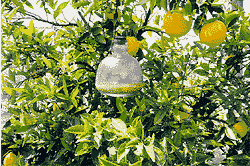| | | Detection & Trapping | | | Pest Detection & Trapping | The Solano County Agriculture Department in cooperation with the State Department of Food and Agriculture conducts annual surveys for major insect pests. Infestations of these pests in other counties in California have cost millions in dollars to eradicate. Detection traps cannot prevent the introductions of pests into Solano County, but will aid in the location of any possible infestations. With early detection, control costs, pesticide usage, and public inconvenience will be minimized.
The following traps are deployed in Solano County?s pest detection surveys:
· Mediterranean Fruit Fly: Jackson Trap with pheromone lure inside of trap.
· Oriental Fruit Fly: Jackson Trap with pheromone lure and insecticide on wick inside of trap.
· Melon Fly: Jackson Trap with pheromone lure and insecticide on wick inside of trap. | ![]() |  | ![]() | | Jackson Trap in Orange Tree. |
· McPhail: Glass bell shaped container with yeast and water as food lure to lure and snare a wide variety of fruit flies (Order Tephritidae) such as Mexican Fruit Fly and Guava Fruit Fly. | ![]() |  | ![]() | | McPhail Trap in Lemon Tree. |
· Gypsy Moth: Delta Trap with pheromone lure inside trap. | ![]() |  | ![]() | | Delta Trap |
· Japanese Beetle: Funnel-like Trap with a synthetic food lure and a pheromone lure. | ![]() |  | ![]() | | Japanese Beetle Trap. |
· Glassy-Winged Sharpshooter: yellow panel sticky trap. | ![]() |  | ![]() | | Yellow Panel Sticky Trap. |
Mediterranean Fruit Fly, Gypsy Moth, Japanese Beetle, Glassy-Winged Sharpshooter, and McPhail traps do not contain any pesticides and should not pose any hazards to humans or pets. They are baited, except the Glassy-Winged Sharpshooter, with synthetic food and/or sex pheromone attractants which lure the insect into any area where it will become trapped. All of the traps, except for the McPhail are checked every two to three weeks. The McPhail is checked weekly.
The Melon Fly and Oriental Fruit Fly are strong fliers. Therefore, in addition to a sex attractant a small amount of insecticide is applied to the wick to stun the flies. Traps will be checked every two weeks.
Our policy is that county trappers may not enter the back yards of properties without the previous permission from the homeowner, but may place a trap or traps in front yards and leave a homeowner letter. Trappers may place a trap into or near a back yard from a front or side yard access, a sidewalk, or from a fence access. Traps are placed in this manner due to the large number of traps that must be put out and the time deadlines and trap relocations required.
If you have any questions or problems regarding the placement of traps on your property, please contact our office or the biologist servicing the trap. Also, please feel free to contact our office for identification of any insects, weeds, or plant diseases you encounter in your yards or gardens.
Thank you for your help in protecting the agricultural and ornamental plant resources of Solano County and California. For information on other target pests and diseases please click here. | ![]() | | |
| | | |